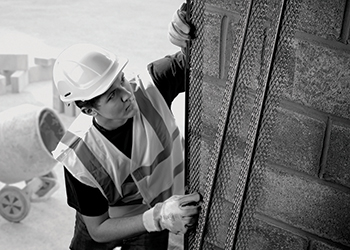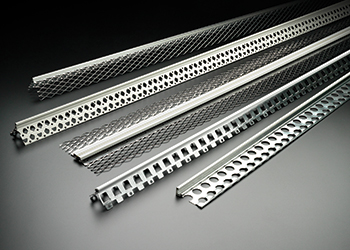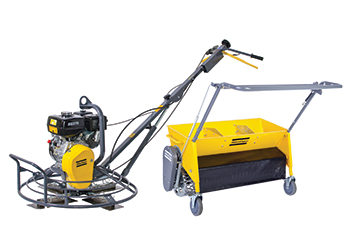
 Installing the correct beads ... ensures a long-lasting result.
Installing the correct beads ... ensures a long-lasting result.
RICHARD PRICE, technical director at Catnic*, explains why it is important to take environmental factors into consideration from design, through specification and into the build and operational phases of a building project.
There are many environmental factors that can affect the longevity and sustainability of concrete buildings. This is particularly true for projects across the Gulf region where climatic conditions take their toll.
Environmental factors are hard to control. As such, buildings need to be designed and constructed with these factors in mind in order to stand any chance of retaining their design rationale. Plasterwork is an important element to any build: internally, it sets the tone for the interior design and external render protects the building envelope from the weather and other inclement environmental conditions. Therefore, careful specification is required.
The environmental factors onsite can severely impact the performance of a plaster system, notwithstanding the quality of the materials selected or the level of workmanship deployed. High humidity levels, extreme temperatures and often – due to the coastal locations of many main cities and urban areas in the region – salinity, are issues to consider at the specification stage for all building components.
As with any element of a building, the foundations and formwork are vital to the success of the project. Plasterer beads are the most modern and efficient way to ensure the resulting plasterwork or render application meets the varying requirements for both the internal and external finishes of a building. A bead helps to achieve a neat, crisp and professional finish while also avoiding cracking and splitting, which can cause issues with the paintwork or wall coverings at a later date.
However, no one size fits all and with specification of ‘equal or equivalent to’ products previously allowing room for costly mistakes, it is important to ensure that even details such as plasterer beads and profiles are specified by name and type, according to the environmental factors at play.
While ‘equal or equivalent to’ provides a platform for contractors and subcontractors to introduce new products, in reality this specification tool allows for a compromise in quality that is borne out of a leaning towards cheaper materials. The result can fall short of the initial design intention. With this in mind and in a bid to ensure only the best quality is installed, more architects and building specifiers are naming the products to be used onsite right down to details such as plasterer beads.
 |
|
Installing the correct beads ... ensures a long-lasting result. |
Depending on the wall finish – wet plaster or drywall internally and render finish externally – it is important that the correct beads are installed to ensure a long-lasting result. Whatever the application, quality is key.
A bead of high quality, from a thicker gauge of steel, will provide rigidness and strength to the installation, helping to ensure a straight edge and delivering a precision finish. A bead that is straight and remains rigid throughout installation will also be faster to install, resulting in reduced time onsite and improved labour costs too.
A well-made bead provides the right depth, helping to ensure the correct level of plaster is applied and therefore stopping the bead from showing through the finish. Punching and forming also needs to be of a consistently high standard and should comply with BS EN 13658-1:2005 and BS EN 14353:2007 as a mark of quality.
A consultant or specialist who can provide an insight on how beads of differing materials will perform in individual circumstances is key to getting the specification right for the job in hand, depending on the environmental factors at play. As a general rule, to ensure the long-term sustainability of the installation, galvanised steel beads should be used internally and stainless steel or unplasticised polyvinyl chloride (PVCu) should be installed externally. For areas of high moisture or in very damp conditions, stainless steel or PVCu are equally suitable.
In particular, PVCu beads should be selected for projects situated in the most aggressive climatic conditions. These can be specified for situations where galvanised beads are not recommended and internally in areas where high moisture or damp exists, in both cases providing an economical alternative to stainless steel.
Stainless steel products should be used where a cement-based render is to be applied. To ensure the longevity of the bead, the use of sand or water contaminated with soluble salts or chlorides in plastering mixes should be avoided. These are likely to increase the risk of metal corrosion. The presence of sea salts in sand used in plasterwork over galvanised beads will often cause rust staining and should also be avoided.
In a region renowned for its striking architecture and where landmark projects are taking shape all the time, specification that embraces the climatic conditions is vital for long-term success.
*Established in 1969, Catnic conceived, developed and pioneered the steel lintel designed for the house building industry, and soon won a major share of the UK market. A Tata Steel enterprise, Catnic is today recognised as a leading brand in the building products sector.





















_0001.jpg)


.jpg)
















.jpg)








.jpg)




